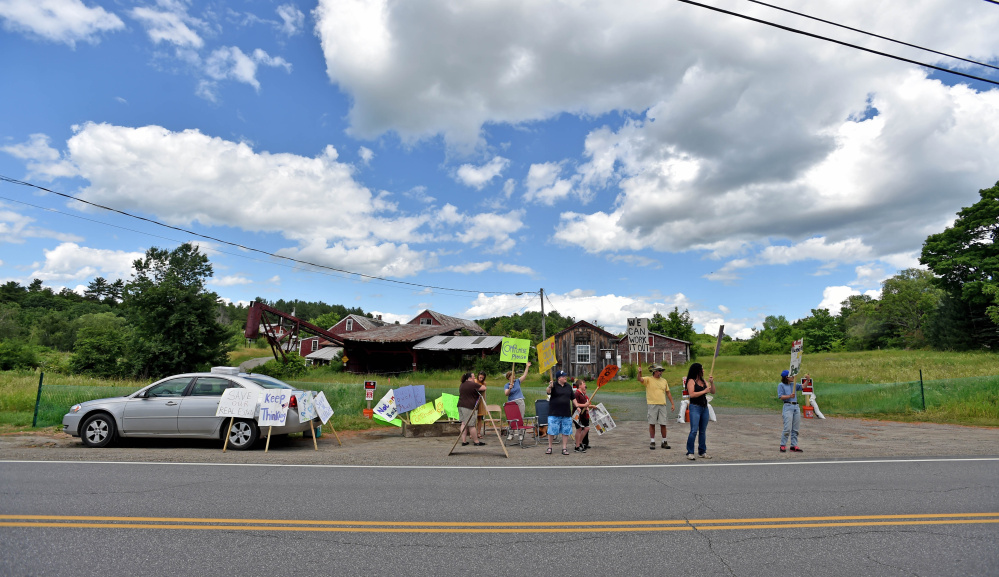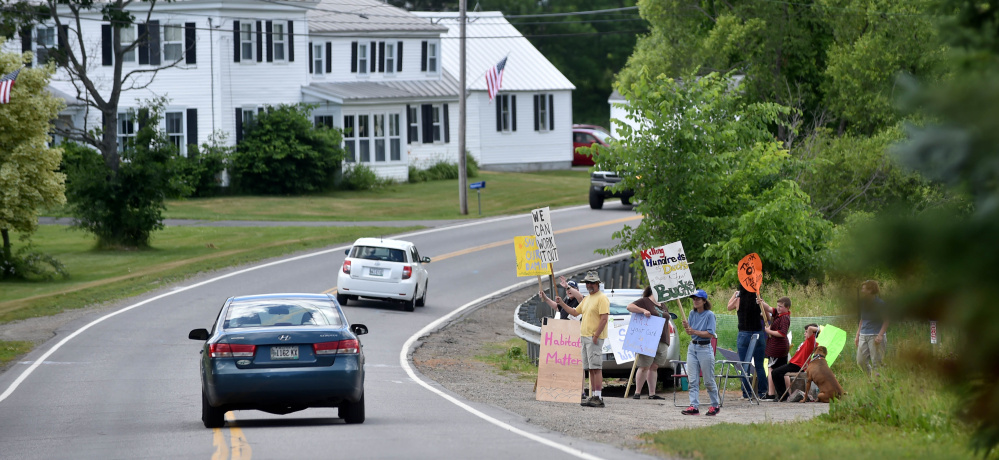VASSALBORO — Protesters carrying colorful signs near the Masse Dam on Main Street shouted at motorists to “Save our wildlife!” Thursday afternoon, the latest effort to stall plans to lower the water level and remove the dam as part of a proposed alewife restoration initiative by government and environmental groups.
“We’re not an opposition group,” said Larisa Batchelder, one of the event’s organizers and a property owner along Outlet Stream. “We agree with getting the alewives up the stream. We just disagree with the manner in which they’re doing it. We don’t think they’re looking at all the factors.”
About a dozen residents had gathered for the protest by 3 p.m. Thursday. Others — mostly property owners along the stream — also have voiced opposition to the planned removal of three dams on the stream as part of the Alewife Restoration Initiative, a project to remove the dams and restore alewife populations to the stream and nearby China Lake.
The protest comes about a week before the initiative is scheduled to lower the water level in the stream in anticipation of the removal of the Masse Dam — one of three that will be removed — planned for later this summer.
Property owners have voiced concerns about lower water levels in the stream that runs through their backyards and drops in property values, and say they are worried about the effects on wildlife that have become acclimated to the state of the stream since the dams have been in place.
Susan Little, a resident who has lived along the stream for 58 years, said she is concerned about the duck population in her backyard.
“It’s going to be a crying shame to drain the water and we’ll be left with just a mud hole,” Little said. “There’s so much there right now.”
Glen Brand, director of the Sierra Club Maine, said dam removal is generally an important and effective way to restore water quality and ecosystems in bodies of water, though it is not unusual for opposition to arise in the process, particularly among property owners who in some instances might have valid concerns.
“The most important action to restore habitat and the health of our rivers is to remove dams, particularly poorly sited ones,” said Brand, who said he was not familiar with the situation in Vassalboro. “There are thousands of examples of dam removal as a part of a restoration plan for rivers, and it’s been very successful all over the country.”
The removal of the Masse Dam, which has been a subject of particular concern among several Vassalboro residents, is expected to dissolve the Mill Pond, an impoundment created by the dam.
“The pond has been there a long time and people are familiar with it,” said Landis Hudson, executive director of Maine Rivers, one of the six groups that make up the Alewife Restoration Initiative. “I understand that. I grew up swimming in a lake. In terms of our lives, people may have always expected that the Mill Pond would be there, but the structure that holds it in a place is a leaking old dam; and to repair it would be expensive, time consuming and difficult.”
The six groups that make up Alewife Restoration Initiative are the China Lakes Region Alliance, the Maine Department of Marine Resources, the Sebasticook Regional Land Trust, the U.S. Fish and Wildlife Service, the China Lake Association, and Maine Rivers. The groups have held several meetings and given presentations on the proposed project, though they have not commissioned an environmental impact statement on the project, Hudson said.
The loss of Mill Pond is something the group has considered carefully, and they determined that the benefits of opening up the stream outweigh the importance of preserving the pond.
“Alewives are not a glamorous fish, but they’re incredibly important,” Hudson said. “A lot of creatures in the Gulf of Maine rely on this as a food source. It may seem kind of abstract when you’re in Vassalboro, but it is real, is very important and is a part of the economy of the state of Maine. To be able to have functional fisheries is very important for economic reasons and others as well.”
Residents say they haven’t been given enough information, including data on how much exactly the water level will change. Water flow out of China Lake into the stream is regulated by a federal order, and Hudson said that will not change. She also said the stream won’t dry up, though residents said they are concerned the levels will drastically drop.
Hudson couldn’t say how much it will change. She said only that she feels confident that the water levels will be enough to support alewife migration upstream.
Alewife Restoration Initiative also has not yet secured a permit to remove the Masse Dam, but is planning to lower water levels in the stream as early as next week in preparation for the removal.
“We’d like them to leave the water as it is for now so we can brainstorm ways to compromise,” Batchelder said. “We understand our stream is going to change, but it’s not a natural water flow if (the Outlet Stream dam at China Lake) is still there.”
Several residents at Thursday’s protest also voiced concerns about wildlife in the area being disrupted by the dam removal, but Hudson and Brand said there probably is no need for worry about it.
“It’s so peaceful and beautiful the way it is now,” said resident Candy Spaulding, 40. “There are lots of animals — ducks, frogs, fish. It’s not going to be the same.”
Dam removal can cause a shift in wildlife populations, but in general it should not be a concern, Brand said.
“When a river is damned, it creates an unnatural environment,” he said. “A free flowing river will create its own habitat. Over years rivers change, some habitat gets moved, wetlands are created, wetlands are dried, that’s what will happen when the river is flowing freely — it will find its own equilibrium. In turn, the habitat will be more inviting to more species.”
Opposition or concern regarding dam removal is not unusual, according to both Brand and Hudson. Residents in Kennebunk are grappling with the same issues in connection with the proposed removal of three dams on the Mousam River, a move that some residents are concerned will harm property values by eliminating the impoundment behind one of the dams.
Of the situation in Vassalboro, Brand said, “I think it’s understandable what the property owners’ fears might be, and I think the solution to that is to really get more information on what the projections would be after the dams are removed.”
“As far as the benefits, absolutely, the benefits to the environment are unqualified,” he said. “Dam removal is the key part of restoring our rivers to their healthiest state, and that in turn has multiple economic and environmental benefits.”
Rachel Ohm — 612-2368
Twitter: @rachel_ohm
Send questions/comments to the editors.







Success. Please wait for the page to reload. If the page does not reload within 5 seconds, please refresh the page.
Enter your email and password to access comments.
Hi, to comment on stories you must . This profile is in addition to your subscription and website login.
Already have a commenting profile? .
Invalid username/password.
Please check your email to confirm and complete your registration.
Only subscribers are eligible to post comments. Please subscribe or login first for digital access. Here’s why.
Use the form below to reset your password. When you've submitted your account email, we will send an email with a reset code.